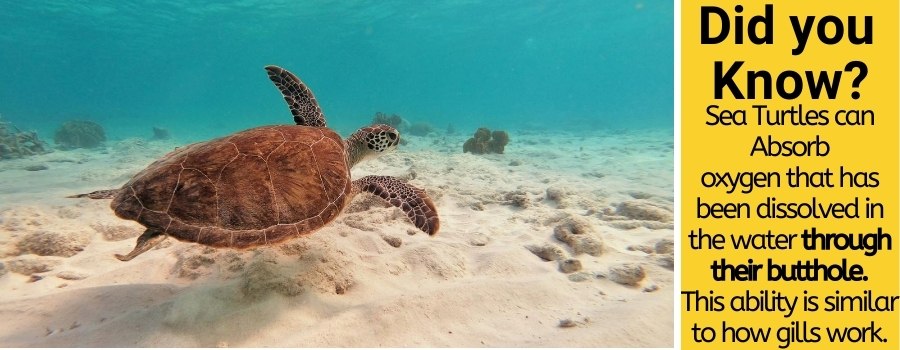 Sea turtles are quite fascinating creatures. Not only are they majestic underwater hippies, but they are also reptiles that live most of their lives in water.
Sea turtles are quite fascinating creatures. Not only are they majestic underwater hippies, but they are also reptiles that live most of their lives in water.
Scratch that, just about all their lives in water. This may be confusing because reptiles breathe air, right?
Well, let’s dive into this a little deeper and find out how these age-old reptiles have adapted to a life at sea.
Do Sea Turtles Breathe Air?
The answer is yes. Sea turtles are reptiles. This means they lay their eggs on land and need to breathe air. So how do sea turtles get away with needing air but spending most of their time below the water? This is because their bodies have adapted to this life, and everything about their respiratory system has adapted to and life of cruising the currents.
How Do Sea Turtles Breathe?
Sea turtles have external nares above their mouths, what we would call nostrils. When sea turtles breathe in the air goes into their trachea, which is flexible and elongated because of their flexible and elongated necks. Nearer to their heart, their trachea splits into two bronchi and that delivers the oxygen to their lungs where it can be absorbed into the body. Sounds kind of similar to the way our bodies work.
But here’s where it gets interesting. Think of sea turtles’ shells as their ribs, but our ribs expand and contract when we breathe. A sea turtles shell can’t quite do that. So, instead sea turtles have muscles inside their shells that expand and contract the way our ribs would and move air in and out of their lungs. Moving their flippers and limbs around also helps because it alters the pressure in the lungs.

Do Sea Turtles Breathe Air Or Water? Do They Need Air?
Sea turtles absolutely need air. As reptiles, regardless of their oceanic lifestyle, they have lungs and need air to provide their bodies with oxygen. They cannot breathe water, but instead are capable of holding their breaths for long periods of time. However, they do eventually need to pop their heads up out of the water for some of that super fresh air.
Do Sea Turtles Have Gills
Sea turtles do not have gills. While that would be super cool, turtles are reptiles and have lungs, meaning no matter the fact that they spend most of their lives underwater, they need to come up to the surface regularly for air. However, sea turtles do have something that works quite similarly to gills. Turtles have a large cloacal, which is essentially their butt, and it is lined with papillae, which are nipple-like anatomical structures. Basically, turtles have nipples in their buttholes. While this sounds absolutely ridiculous, it gets better. These papillae have an incredibly rich blood supply and that increases the surface area of their cloacal. Using these papillae, sea turtles can absorb dissolved oxygen from water similarly to the way gills do. So, to put it in extremely simple terms, sea turtles have gills in their buttholes.
Where Do Sea Turtles Breathe From?
Like every reptile and most creatures, turtles have lungs. In order to get oxygen into these lungs and then into the rest of their bodies, they, much like us, have nostrils or in their case, nares. Fresh air travels from their noses into the trachea into their lungs where it is then absorbed into the body.
Do All Turtles Breathe Air?
Yes. All turtles are reptiles, and all reptiles breathe air. I think its important to remember that sea turtles are completely capable of being out of water. They waddle up to beaches to nest and lay their eggs which can take up to three hours before they drag themselves back into the ocean. So, while they rely on air to breathe, they still thrive in water. Everything else about them suits a life at sea. Their powerful flippers, their expert diving skills, the ability to migrate across oceans. They simply need to pop up for air once in a while.
How Can Sea Turtles Breathe Underwater?
This is where I get incredibly jealous of sea turtles. Their bodies have done what ours can’t: adapted to a life under water. Sea turtles are cold blooded, meaning their body temperature depends on and adapts to their environment. When turtles are underwater, everything in their body shifts to conserve and distribute oxygen efficiently. Their heart rate slows dramatically and can slow to a heart beat every 9 minutes, and oxygen is released slowly to only the most important organs such as the brain and heart. This slow release of oxygen allows them to remain under water for long periods of time.
Sea turtles also have a massive lung capacity compared to other land reptiles. Their lung capacity exchange per breath can range between 27%-80%! This allows them to completely exchange all the gasses in their lungs very quickly before taking another deep breath and diving back down.
However, this only works when the turtle is chilling and not stressed out. Turtles that are caught in nets or are being chased can’t hold their breath for very long because panic increases their heart rate and essentially undoes everything that allows them to stay underwater. Panicked turtles use up their oxygen quickly and that is why turtles caught in nets or otherwise restrained often drown.
How Long Can Sea Turtles Stay Underwater And Hold Their Breath?
Have you ever held your breath under water? I think I can just about do a minute, but after 30 seconds my chest starts feeling tight, I can feel myself floating to the surface, and when I do finally come up for air, I’m puffing around like I just ran a marathon. And that’s just after a minute. Well, sea turtles can stay underwater for 4-7 hours if they are not stressed. HOURS. Some turtles can even hibernate underwater for months, depending on the species.
How Long Can A Green Sea Turtles Stay Underwater?
Most turtles do come up for air quite regularly, because why wouldn’t they. But when hunting for food or migrating across vast oceans, the Green Sea Turtle can stay underwater for up to 7 hours. Green Sea turtles are often seen closer to the shore and are also known for enjoying a bit of a sun lounge on land. In fact, the Eastern Pacific Green Turtle is one of the few marine turtles known to leave the ocean for something other than nesting.
Can Green Sea Turtles Breathe Underwater?
Once again, all sea turtles are reptiles and no reptiles can breathe underwater. The Green Sea Turtle is no exception to this. While they can remain underwater for long periods of time, they cannot breathe underwater. Eventually the oxygen will run out, no matter how efficiently it is distributed throughout the body, and all sea turtles will eventually come up for air.
Related questions.
Can turtles breathe out of their buttholes?
Turtles can’t so much breath out of their buttholes, but their buttholes can absorb oxygen that has been dissolved in the water. This ability is similar to how gills work.
Do all turtles live underwater?
Not all turtles live underwater. There are many species of turtles, sea turtles, freshwater turtles, the list goes on. But many live on land as much as they do in water. You can often find them in ponds or lakes where they have the opportunity to enjoy both terrains.
In conclusion, turtles are super cool. They are definitely living my dream life. Surfing the seas, riding waves, and cruising through water. These gentle giants aren’t held back by their need for air but have instead adapted to enjoy the best of both worlds. Everything about them is exciting, their shells, their powerful flippers, and even their unique buttholes.






